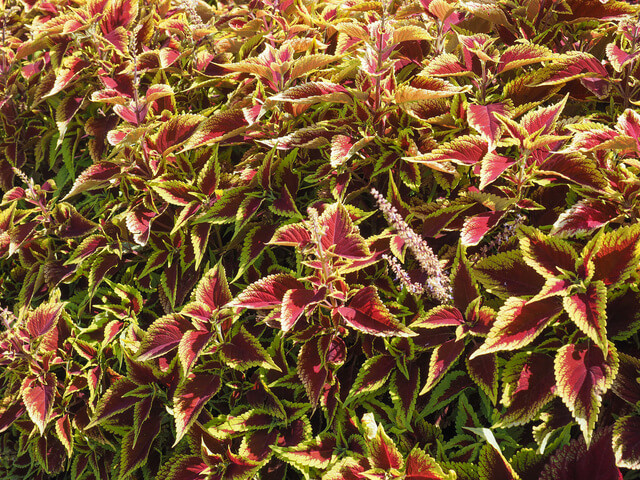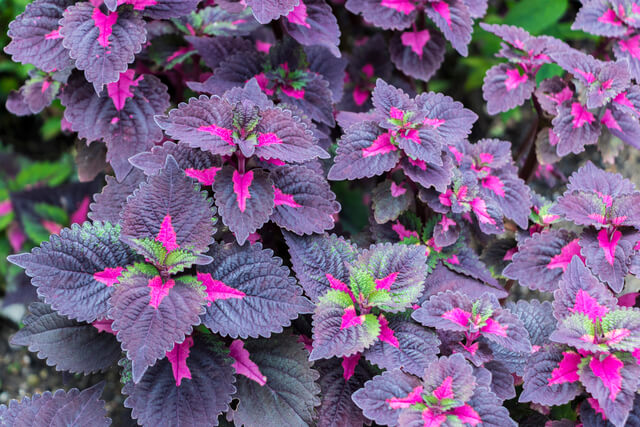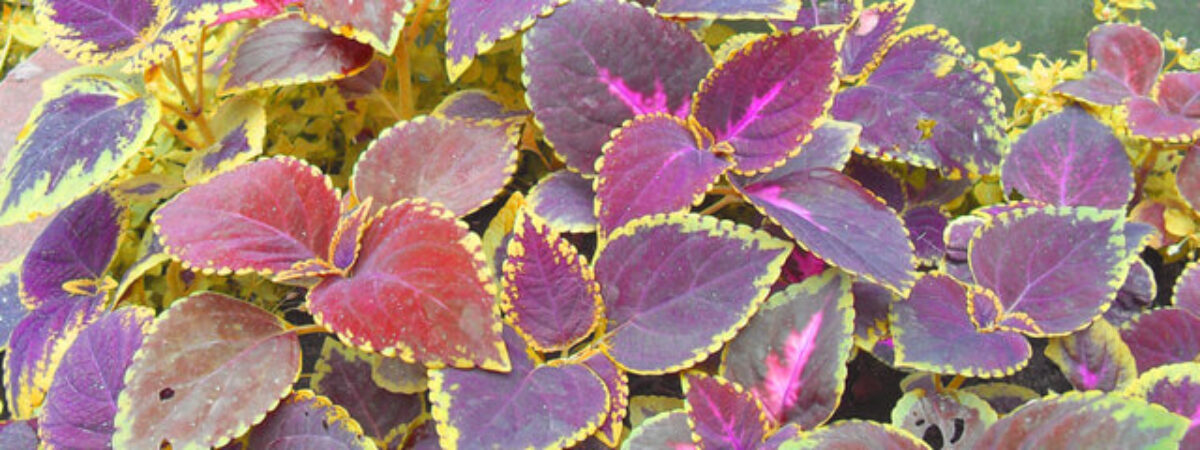Coleus plants are scientifically called Plectranthus scutellarioides and belong to the family of Lamiaceae i.e. to the mint family. This plant is a herbaceous perennial that is mostly grown as annual plants.
Coleus is commonly grown as an annual bedding plant or in pots to create spectacular, colorful margins in full sun, a flash of light, and partial shade.
Coleus plants, also recognized as Mayana and colored nettle, are easy to cultivate and resilient, with vibrant colors, a broad diversity of foliage hues, leaf shapes, and forms.
Coleus plants have square stems and leaves that are positioned squarely opposite one another. It bears little blue to white flowers, however, they are unimpressive and are frequently cut off to save the plant's strength. Click To TweetColeus plants have square stems and leaves that are positioned squarely opposite one another. It bears little blue to white flowers, however, they are unimpressive and are frequently cut off to save the plant’s strength.
It is possible for leaves to have a variety of shapes, styles, and colors. Novel species with much more odd colors and textures are introduced on a routine basis by breeders.
These plants grow best in USDA Hardiness zones of 10 to 11 and in other areas Coleus plants are grown as annuals.
Varieties
There are lots of coleus varieties with different colors, leaf patterns, and patterns to choose from. Each year, new cultivars are created, and garden stores tend to concentrate on a few that have shown to be the most preferred among their consumers.
To acquire the most unusual types, you may need to visit numerous nurseries or go online. The following are some of the types to watch for:
Wizard series: These are little plants that range in size from 12 to 14 inches tall and come in a variety of color combinations. They are well-known for being simple to raise from seed.
Kong series: This coleus cultivar has enormous 6-inch leaves on 2-foot-tall plants. These are rather vulnerable to the bright sun.
‘Black Dragon’ features rich maroon leaves with curled edges, making it a unique cultivar. These reach a height of 18 inches.
Premium Sun series: These varieties have been designed to thrive in direct sunlight.
Fairway series: These are miniature coleus types with leaf designs and colors ranging from 6 to 10 inches in height.

Coleus for semi-shade:
‘Brilliancy’ The leaves are bright red with green scalloped borders.
‘Fishnet Stockings’ The foliage are lime green with deep purple veins.
‘Mardi Gras’ It has red, green, and yellow foliage and is small.
‘Japanese Giant’ It has large maroon leaves that are tinged with pink and purple.
Coleus for partial to full sun:
‘Pineapple’ The leaves are fresh lemon in color, with maroon stalks.
‘Solar Shadow’ It features bright crimson ruffled borders and points on its foliage.
‘Alabama Sunset’ The foliage is brick-red with golden margins.
Growing Guide
Depending on your environment, you can grow coleus in the sunlight or in the shade in midday. Direct sun will pull out the greatest foliage color and the strongest plants if you reside in a cold, humid climate. Partially shaded areas are desirable in hot, arid climates.
Coleus dislikes cold weather and thrives in temperatures over 70 degrees Fahrenheit. Plants require a lot of water, thus they require a very well potting mix with good drainage facility rather than one in which their roots are buried in moist dirt.
Even though plants can thrive in just water, soil that is constantly moist is a different story, and in this instance, the roots will rot.
Coleus can be simply planted from seeds inside around 10 weeks before your area's last frost date.Plants should be set out when all risk of frost has passed. Click To TweetColeus can be simply planted from seeds inside around 10 weeks before your area’s last frost date.Plants should be set out when all risk of frost has passed.
Pick a good location that is wind-protected. Coleus branches are prone to breaking. Coleus requires soil that drains properly.Following planting, give the plant plenty of water.Maintain the roots ball humid but not soggy in the first week after planting.
When the top layer of soil is dry, moisten it. Young plants should have their growing shoots pinched periodically to enhance spreading and bushier growth. Apply fertilizer in the summertime with half-strength liquid fertilizer.
Late into the season, cut the blossom spikes to lengthen the plant’s life and encourage the emergence of new vibrant leaves.
Take samples from the plants prior to the second frost in the autumn in cool climates and establish them in water. And for winter, place the planted cuttings in tiny pots near a sunny spot.

Caring Guide
Soil
Coleus loves soil that is regularly damp, rich, and drains well. Compost or other organic components should be applied to the soil before sowing. Any better potting mix will suffice for potted plants. Make sure the container you purchase has good drainage.
The open consistency of potting soil is ideal for container-grown coleus, and starting with a good mix with a somewhat acidic to neutral pH of 6.0 to 7.0 is always a good idea.
Make sure the pot has a good draining facility so the soil doesn’t stay moist all the time, which can result in fungal diseases.
Light
Coleus is a perennial shrub that prefers part shade to full shade, however, the amount of light each variety receives will vary.
The traditional plant coleus thrives in part to full shade, although newer varieties, such as the Wizard series, thrive in full sun.
In most ancient Coleus cultivars, the excessive sun will burn the leaves and cause the color to fade. Coleus thrives in screened early light and midday shade, particularly in hot areas.
Throughout the summer months, plants grown in pots inside normally get more than enough light from indirect sunshine, but during the cold season, they might have to be subjected to controlled sunlight. They don’t require a lot, but they often require some sunshine.
Water
Coleus plants do best in damp, but not waterlogged, soil. The soil ought not be wet all of the time, but protracted droughts can limit the growth and development of plants and cause the leaves to become brown around the borders.
Allow the moisture to evaporate out between foliar feeding and only water whenever the top inch seems dry. Mulch will assist the soil to retain water for extended periods of time, but avoid wood mulch, as it is harmful to coleus.
Also, don’t let the mulch reach the stems, since this might encourage decay and serve as a hiding place for slugs. In warmer weather, Coleus in pots may need to be watered twice a day. Outside containers may need watered twice daily.
Temperature and Humidity
Coleus flourishes in hot, humid circumstances as a tropical plant. In temperate areas, even the tiniest touch of frost is enough to kill the plants. When temperatures drop into the 50 degrees, bring plants inside or cover them with a blanket.
Before the weather gets cold and chilly, make sure you take clippings for propagation. Vents in air conditioners and other drafty areas should be avoided when growing indoor plants.
The plants will appreciate some dampness from a mister or a bathroom atmosphere in dry conditions. Wait until the weather reaches 70 degrees Fahrenheit or above before bringing potted plants outside in the springtime.
Fertilizers
With good soil, coleus plants may not require any fertilization at all. Add a balanced slow-release fertilizer to the bed if the soil is poor. If you go mild on the fertilizer, you’ll get the greatest color from your coleus leaves.
Liquid fertilizer should be applied to container-grown plants once a month. Container plants require more food than those in the home garden because regular watering drains mineral minerals from the soil.
Propagation
Using stem cuttings and planting them is a simple way to reproduce favorite coleus plants. Trim a 4- to 6-inch tall stem tip with a fine shearing scissor.
Ensure to remove the stem just below a leaf node. Discard all of the leaves from the cutting’s bottom half. Dip the stem’s end in a rooting hormone solution, then place it in a moistened potting medium with the uncovered leaf nodes covered by the dirt.
Cover the container in a plastic bag, ensuring that the plastic does not come into contact with the cutting.
Keep the wrapped cutting in a sunny, warm position for 2 to 3 weeks, until and unless new roots appear. Discard the plastic and keep the young plant in a sunny, warm environment.
Problems
Infections rarely affect Coleus until the environment becomes cool and moist. Expect to notice indications of fungal illnesses like mildew if this occurs. Make sure the plant has adequate drainage since stagnant water can promote fungal roots and stem rot.
Conclusion
Coleus is a year-round plant with a wide range of uses. Red coleus blossoms can be used inside in leaf decorations or grown in soil in the same jardiniere in the home as it was on the balcony in the warmer months.
It will yield branches of multicolored leaves for centerpieces and extra plants in either place. The leaves must be exposed to sunlight in order to maintain their vibrant color.
Hope this guide will help you to grow your Coleus plants efficiently. For any queries regarding the Coleus plant feel free to ask in the comments below.
You may also like to read
How to Plant, Grow And Care for Cuban Oregano – A Complete Guide






